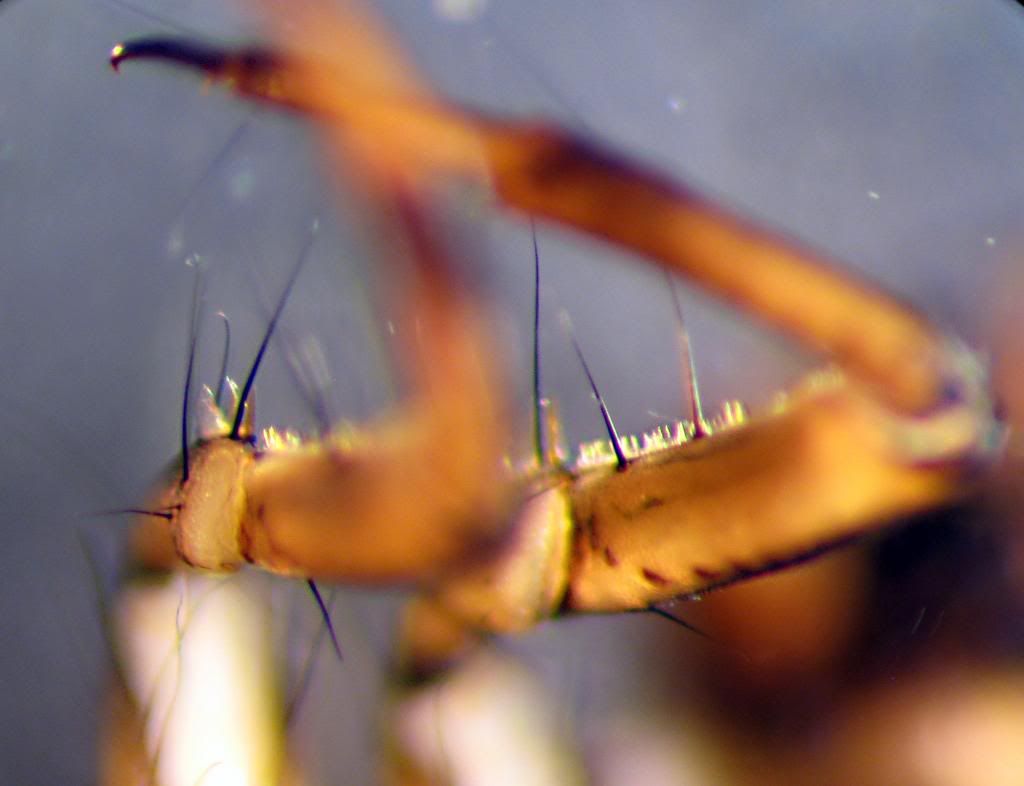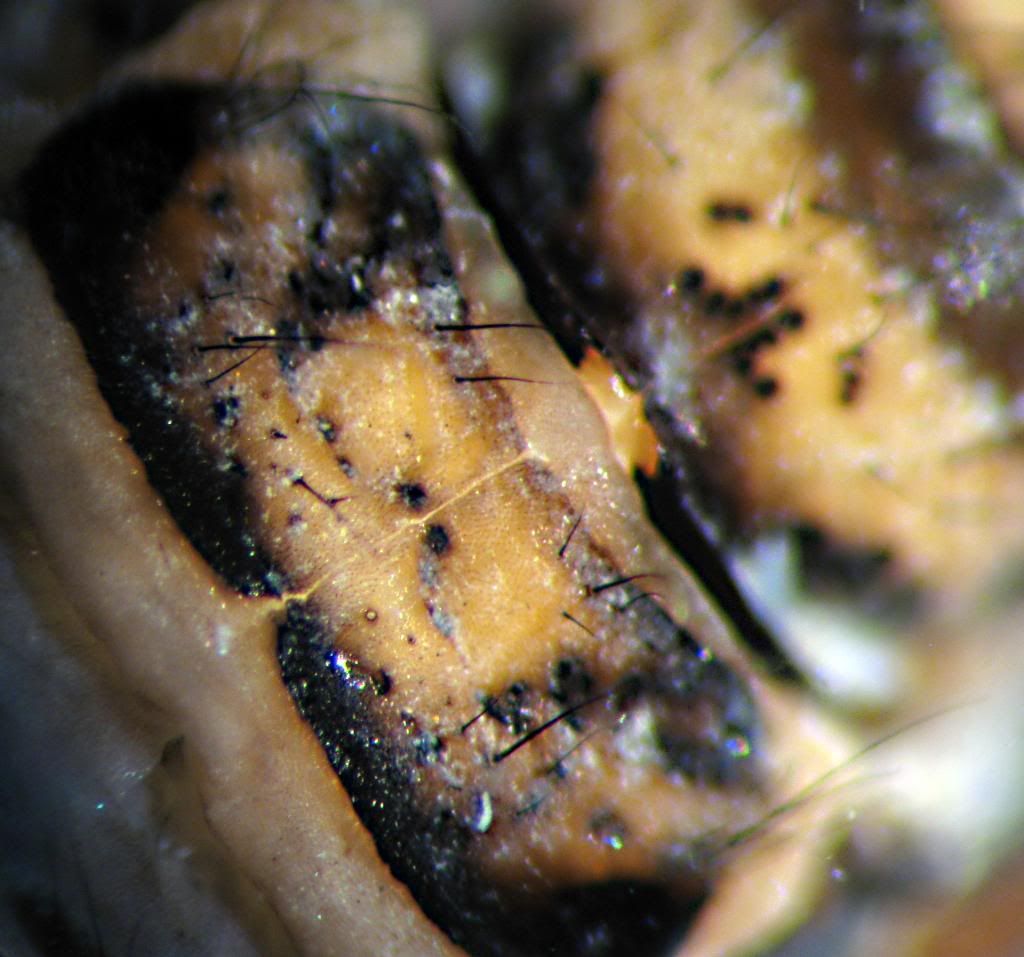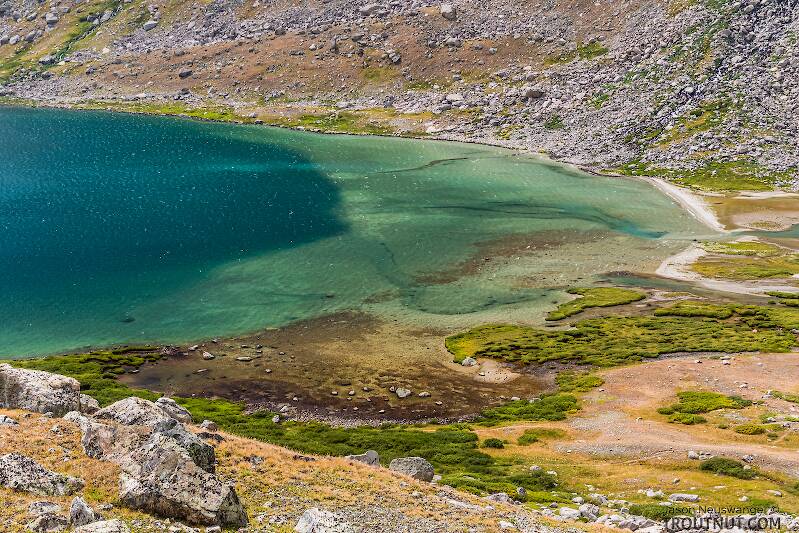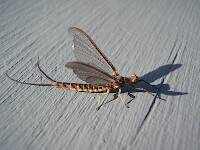
Blue-winged Olives
Baetis
Tiny Baetis mayflies are perhaps the most commonly encountered and imitated by anglers on all American trout streams due to their great abundance, widespread distribution, and trout-friendly emergence habits.
Featured on the forum

With a bit of help from the microscope, this specimen keys clearly and unsurprisingly to Hydropsyche.

Troutnut is a project started in 2003 by salmonid ecologist Jason "Troutnut" Neuswanger to help anglers and
fly tyers unabashedly embrace the entomological side of the sport. Learn more about Troutnut or
support the project for an enhanced experience here.
Entoman on Jan 18, 2013January 18th, 2013, 10:33 am EST
Oops and wow! A lot of activity occurred while writing my post! I love it! :)LOL
"It's not that I find fishing so important, it's just that I find all other endeavors of Man equally unimportant... And not nearly as much fun!" Robert Traver, Anatomy of a Fisherman
Crepuscular on Jan 18, 2013January 18th, 2013, 10:48 am EST
. I cannot see the number of setae at the mesonotal sa1 but pretty sure it is something near Limnephilus externus/extractus. Other characters that would remove some uncertainty would be the presence/absence of dorsal chloride epithelia (I suspect they are absent) and presence/absence of accessory setae on the lateral femur surfaces. I cannot see the accessory setae in the photo but they can be small and clear. The best way to see them is to look at femur from a dorsal or ventral view. Then you can see them sticking out from the lateral surface if they are present and not broken off.
dorsal chloride epithelia are absent
See if these help:


Creno on Jan 18, 2013January 18th, 2013, 11:05 am EST
that helps - I can rule out a couple more. The femur area one needs to see is out of focus but I still don't think the accessory setae are there. Definitely multiple setae in mesonotal sa1, that drops L.extractus. probably all you can do at this point as I don't have specimen of L.rhombicus to compare with some other stuff.
Entoman on Jan 18, 2013January 18th, 2013, 1:59 pm EST
The first one Neophylax , Kurt called it a dot-Winged sedge, I'm not up on caddisfly common names...
You inadvertently raise a good point, Eric. It must be admitted calling this particular caddis by a common name is a bit misleading. The truth is most caddis don't have established commom names to be "up on" and species of the genus Neophylax are certainly in this large group. However, for the benefit of those Troutnutters who have asked repeatedly that we talk "English" as much as possible, it's worth remembering to include some name even if none established really exist. With this goal in mind, the only thing that makes sense is to use the "non-established" common names (polite way of saying made up out of whole cloth by the authors) given them from the three caddis sources most anglers look to for better or worse: Schwiebert, LaFontaine, and Ames. Since the three often give different names for the same critter (as with this one), I usually go with the one I like best:) In this case it was Ames chosen, mostly because he's the latest and the others were published before the Neophylax genus was moved over to the Uenoidae family.
...and I would expect to see it in the summer and fall as well.
Ah! Very good. Perhaps I should have quoted LaFontaine instead, who called them "Autumn Mottled Sedges."
For the 2nd critter (Limnephilus sp.), both Lafontaine & Ames agree on Summer Flier Sedge as a generic common name, so that one might actually have a chance to become "common" someday.;)
"It's not that I find fishing so important, it's just that I find all other endeavors of Man equally unimportant... And not nearly as much fun!" Robert Traver, Anatomy of a Fisherman
Oldredbarn on Jan 18, 2013January 18th, 2013, 2:21 pm EST
You guys are rocking now! :)
Dave...Wonderful post up there a few spots! Citizen science is a big deal at Cornell's Ornithological Lab...They have folks watching and then posting their bird sightings and they use the data for migratory info etc.
Good stuff!
Spence
Dave...Wonderful post up there a few spots! Citizen science is a big deal at Cornell's Ornithological Lab...They have folks watching and then posting their bird sightings and they use the data for migratory info etc.
Good stuff!
Spence
"Even when my best efforts fail it's a satisfying challenge, and that, after all, is the essence of fly fishing." -Chauncy Lively
"Envy not the man who lives beside the river, but the man the river flows through." Joseph T Heywood
"Envy not the man who lives beside the river, but the man the river flows through." Joseph T Heywood
Entoman on Jan 18, 2013January 18th, 2013, 2:36 pm EST
You guys are rocking now! :)
You're right, Spence. This one's going featured!
"It's not that I find fishing so important, it's just that I find all other endeavors of Man equally unimportant... And not nearly as much fun!" Robert Traver, Anatomy of a Fisherman
Entoman on Jan 25, 2013January 25th, 2013, 10:42 am EST
You're right, Spence. This one's going featured!
Well, that sure helped with participation...:)
"It's not that I find fishing so important, it's just that I find all other endeavors of Man equally unimportant... And not nearly as much fun!" Robert Traver, Anatomy of a Fisherman
Crepuscular on Jan 26, 2013January 26th, 2013, 6:24 am EST
You inadvertently raise a good point
It really wasn't inadvertent, i just didn't want to bash the common names of caddis. The common names that have gained "acceptance" or are recognized by many fly fishers, seems to me to be the ones like the Brachycentrids,the Grannom, or Mother's Day Caddis, that are consistent, and unique in color, and don't include the word Sedge. They also have some history surrounding them. The problem with most of the other caddis species that we are interested in as trout food are somewhat ubiquitous in color, mabe not ubiquitous exactly, but the pallete is somewhat limited to shades of brown, grey, black, yellow and green. yes there are definite differences, but most ( not all) will fall into a limited amount of variation when it comes to wing and body color. The similarities between adults of different species, even different families, seem to have led fly fishers to "call em like they see em" so a tan caddis becomes "Tan Caddis" or an olive caddis becomes "Olive Caddis" and so on down the line. And I kinda like it. It's not very creative and lacks the history that most of the Mayflies of interest to fly fishers have, but when discussing a certain emergence of caddisflies, when someone says "oh they've been eating a #18 olive caddis" it's pretty descriptive. As opposed to "oh they've been eating a #14 Lady Beaverkill", for someone who is not up on regional fly fishing dialect, that fly may be a mystery.
Just trying to keep this going on a snowy day. :)
Entoman on Jan 26, 2013January 26th, 2013, 12:26 pm EST
...and don't include the word Sedge.
Yes, the word Sedge is a British/Canadian common name that I agree does seem a bit affectatious and out of place when used in the States. This is quasi-speculation, but I believe Schwiebert may have started it with his book "Nymphs"? Regardless, authors following his groundbreaking book seem to have followed suit almost without exception. I assume this is both out of respect for the great author as will as trying to facilitate the establishment of common names (which is defeated if they contradict each other too much). Heck, even Western authors the furthest away from European influence like Hafele and Schollmeyer have taken to calling Hydropsyche species "Spotted Sedges" and Rhyacophila species "Green Sedges". Hey wait a minute, how is this different from Olive or Tan Caddis?:)LOL
The similarities between adults of different species, even different families, seem to have led fly fishers to "call em like they see em" so a tan caddis becomes "Tan Caddis" or an olive caddis becomes "Olive Caddis" and so on down the line.
This seems to be the case, but it's probably due more to a general lack of knowledge about them among most anglers in comparison to their mayfly knowledge. IMO, it seems no more helpful with caddis than a similar nomenclature would be with mayflies. Both orders retain similar shapes in the adult stage regardless of family and only look different in size and color to the uninformed. Caddis may look alike as adults, but as with mayflies there are important behavioral and morphological differences between them (at least to the family level) that are important for the angler to know.
As opposed to "oh they've been eating a #14 Lady Beaverkill", for someone who is not up on regional fly fishing dialect, that fly may be a mystery.
Good point. The flip side though is once it's understood to apply to a certain species group (like "Hendrickson") it can be more clarifying than a descriptive name. For example, Pale Morning Duns (E. excrucians) are often quite dark and often hatch in the evening.:)
Actually, the common name problem is a little simpler with caddis in a sense. Like with mayflies, the major species have fairly universal common names. The big difference between the two is that with caddis the minor species have no established common names so it's practical to refer to what I call the "Big Three" for them. In contrast, the minor mayfly species seem to have as many common names as there are regions and books about them.:) With caddis we have the opportunity to avoid an often contradictory and confusing common nomenclature as exists with the mayflies.
"It's not that I find fishing so important, it's just that I find all other endeavors of Man equally unimportant... And not nearly as much fun!" Robert Traver, Anatomy of a Fisherman
Creno on Jan 31, 2013January 31st, 2013, 2:27 pm EST
Eric sent me several well preserved/labeled specimens of this critter and it is not L. externus. It does match a European description for L. rhombicus quite well except for the coloration of the pronotum so it could very well be L. rhombicus. I looked at the Pennsylvania caddis list and of the Limnephilus species listed Eric's specimens could not be any of them except L. rhombicus. One Limnephilus species with which Eric specimens should be compared is L. femoralis. L. femoralis has a reported distribution that is further north than Pennsylvania. I don't have L. femoralis specimens available right now because of a move but maybe in a couple months....
Crepuscular on Jan 31, 2013January 31st, 2013, 11:53 pm EST
Dave, thank you very much for taking the time to look at the samples I sent!
Eric
Eric
JOHNW on Feb 3, 2013February 3rd, 2013, 10:10 am EST
Thank god this thread is bug pics. I thought someone was going to spill the beans on my favorite winter time fishery.
JW
JW
"old habits are hard to kill once you have gray in your beard" -Old Red Barn
Crepuscular on Feb 3, 2013February 3rd, 2013, 11:17 am EST
No Jesse let everyone in on your "secret" a while ago. ;)
Wbranch on Feb 3, 2013February 3rd, 2013, 6:40 pm EST
Crepuscular wrote;
"No Jesse let everyone in on your "secret" a while ago. ;)"
Ain't that the truth? That is one of the funnier comments I've seen here in awhile.
I found a new "secret" wild brown trout stream pretty much all open water, 20' - 30' wide, all open tackle so that is probably why it is seldom fly fished. In my favor is it's many counties removed from the hallowed Cumberland County iconic shrines to fly fishing.
"No Jesse let everyone in on your "secret" a while ago. ;)"
Ain't that the truth? That is one of the funnier comments I've seen here in awhile.
I found a new "secret" wild brown trout stream pretty much all open water, 20' - 30' wide, all open tackle so that is probably why it is seldom fly fished. In my favor is it's many counties removed from the hallowed Cumberland County iconic shrines to fly fishing.
Catskill fly fisher for fifty-five years.
JOHNW on Feb 5, 2013February 5th, 2013, 11:56 am EST
No Jesse let everyone in on your "secret" a while ago. ;)
Oh well we all know there really are no secrets when it comes to streams and Big Springs is a tough nut to crack in many ways. Besides I figure my winter solitude won't be that hampered as I actually enjoy fishing in moderately crappy winter weather.
"old habits are hard to kill once you have gray in your beard" -Old Red Barn
Quick Reply
Related Discussions
Topic
Replies
Last Reply
0
Sep 23, 2006
by Litobrancha
by Litobrancha
8
Jun 16, 2013
by PaulRoberts
by PaulRoberts
0
Sep 23, 2006
by Litobrancha
by Litobrancha







